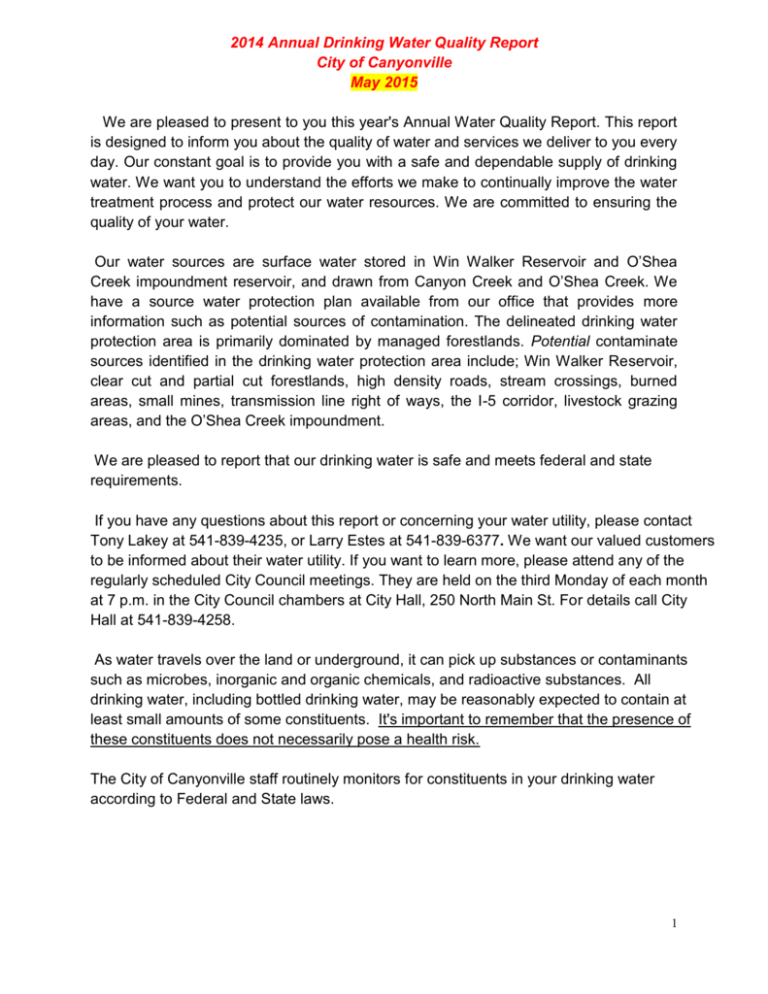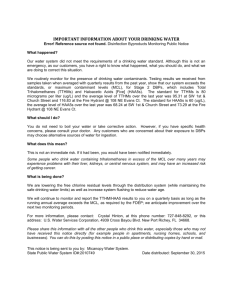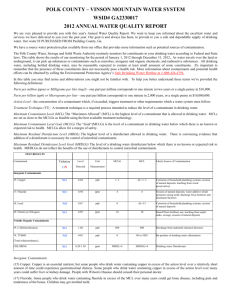2014
advertisement

2014 Annual Drinking Water Quality Report City of Canyonville May 2015 We are pleased to present to you this year's Annual Water Quality Report. This report is designed to inform you about the quality of water and services we deliver to you every day. Our constant goal is to provide you with a safe and dependable supply of drinking water. We want you to understand the efforts we make to continually improve the water treatment process and protect our water resources. We are committed to ensuring the quality of your water. Our water sources are surface water stored in Win Walker Reservoir and O’Shea Creek impoundment reservoir, and drawn from Canyon Creek and O’Shea Creek. We have a source water protection plan available from our office that provides more information such as potential sources of contamination. The delineated drinking water protection area is primarily dominated by managed forestlands. Potential contaminate sources identified in the drinking water protection area include; Win Walker Reservoir, clear cut and partial cut forestlands, high density roads, stream crossings, burned areas, small mines, transmission line right of ways, the I-5 corridor, livestock grazing areas, and the O’Shea Creek impoundment. We are pleased to report that our drinking water is safe and meets federal and state requirements. If you have any questions about this report or concerning your water utility, please contact Tony Lakey at 541-839-4235, or Larry Estes at 541-839-6377. We want our valued customers to be informed about their water utility. If you want to learn more, please attend any of the regularly scheduled City Council meetings. They are held on the third Monday of each month at 7 p.m. in the City Council chambers at City Hall, 250 North Main St. For details call City Hall at 541-839-4258. As water travels over the land or underground, it can pick up substances or contaminants such as microbes, inorganic and organic chemicals, and radioactive substances. All drinking water, including bottled drinking water, may be reasonably expected to contain at least small amounts of some constituents. It's important to remember that the presence of these constituents does not necessarily pose a health risk. The City of Canyonville staff routinely monitors for constituents in your drinking water according to Federal and State laws. 1 Note that of the 80+ constituents for which we routinely monitor, including bacteriological testing, there were 2 violations. The table on the next page shows the results of our monitoring, for constituents that were detected, during the period of January 1st to December 31st, 2013. In this table you will find many terms and abbreviations you might not be familiar with. To help you better understand these terms we've provided the following definitions: Non-Detects (ND) - laboratory analysis indicates that the constituent is not present. Parts per million (ppm) or Milligrams per liter (mg/l) - one part per million corresponds to one minute in two years or a single penny in $10,000. Parts per billion (ppb) or Micrograms per liter - one part per billion corresponds to one minute in 2,000 years, or a single penny in $10,000,000. Nephelometric Turbidity Unit (NTU) - nephelometric turbidity unit is a measure of the clarity of water. Turbidity in excess of 5 NTU is just noticeable to the average person. Action Level - The concentration of a contaminant which, if exceeded triggers treatment or other requirements which a water system must follow. Treatment Technique (TT) - A treatment technique is a required process intended to reduce the level of a contaminant in drinking water. Maximum Contaminant Level (MCL) - The “Maximum Allowed” (MCL) is the highest level of a contaminant that is allowed in drinking water. MCL’s are set as close to the MCLG’s as feasible using the best available treatment technology. Maximum Contaminant Level Goal (MCLG) - The “Goal” (MCLG) is the level of a contaminant in drinking water below which there is no known or expected risk to health. MCLG’s allow for a margin of safety. TEST RESULTS Contaminant Violati Level on Detecte Y/N d Microbiological Contaminants Unit Measurem ent Turbidity Lowest mo. avg. of samples meeting turbidity limits, 0.027 NTU N Highest single reading, 0.085 NTU MCL G MCL Likely Source of Contamination Soil runoff N/A TT 0.300 NTU maximum Inorganic Contaminants Copper Date collected, 8/13/13 N Next test is March 2016 ppm 1.3 AL=1.3 Corrosion of household plumbing systems; erosion of natural deposits; leaching from wood preservatives 2 Lead Date collected, 8/13/13 Next ppb 0 AL=15 test is January , 2016 Disinfection Byproducts, Byproduct Precursors, Disinfectant Residuals TTHM, Total trihalomethanes HAA5, Halo acetic Acid 5 N Corrosion of household plumbing systems, erosion of natural deposits y 101 ppb ppb N/A 80.0 ppb By-product of drinking water chlorination y 74.5 ppb ppb N/A 60.0 ppb By-product of drinking water chlorination Table notes: Turbidity. The maximum allowable limit is 0.300 NTU. The highest individual reading was 0.114 NTU. The lowest monthly average was 0.024 NTU. This information is required to be included in this table, although no violation was incurred. Copper. Testing for copper is required every three years. The most recent sampling was performed on 8/13/13. Although there was a “detect”, no violation was incurred. The EPA has determined that your water is safe at these levels. The next scheduled tests are for the first quarter of 2016. Lead. Testing for lead is required every three years. The most recent sampling was performed on 8/13/13. There was a “detect” and no violation has incurred. The EPA has determined that your water is safe at these levels. The next scheduled tests are for the first quarter of 2016. TTHM. There were detections higher than the MCL. A violation has occurred. HAA5. There were detections higher than the MCL. A violation has occurred. As you can see by the table our system had 2 violations. We have learned through our monitoring and testing that some constituents have been detected. The EPA has determined that your water IS SAFE at these levels. MCL’s are set at very stringent levels. To understand the possible health effects described for many regulated constituents, a person would have to drink 2 liters of water every day at the MCL level for a lifetime, to have a one-in-a-million chance of having an adverse health effect. 3 The following three statements are “required language”; they are included for your information. All sources of drinking water are subject to potential contamination by substances that are naturally occurring or man made. These substances can be microbes, inorganic or organic chemicals and radioactive substances. All drinking water, including bottled water, may reasonably be expected to contain at least small amounts of some contaminants. The presence of contaminants does not necessarily indicate that the water poses a health risk. More information about contaminants and potential health effects can be obtained by calling the Environmental Protection Agency’s Safe Drinking Water Hotline at 1-800-426-4791. Some people may be more vulnerable to contaminants in drinking water than the general population. Immuno-compromised persons such as persons with cancer undergoing chemotherapy, persons who have undergone organ transplants, people with HIV/AIDS or other immune system disorders, some elderly, and infants can be particularly at risk from infections. These people should seek advice about drinking water from their health care providers. EPA/CDC guidelines on appropriate means to lessen the risk of infection by cryptosporidium and other microbiological contaminants are available from the Safe Drinking Water Hotline (1-800-426-4791). If present, elevated levels of lead can cause serious health problems, especially for pregnant women and young children. Lead in drinking water is primarily from materials and components associated with service lines and home plumbing. The City of Canyonville is responsible for providing high quality drinking water, but cannot control the variety of materials used in plumbing components. When your water has been sitting for several hours, you can minimize the potential for lead exposure by flushing your tap for 30 seconds to 2 minutes before using water for drinking or cooking. If you are concerned about lead in your water, you may wish to have your water tested. Information on lead in drinking water, testing methods, and steps you can take to minimize exposure is available from the Safe Drinking Water Hotline or at www.epa.gov/safewater/lead. -----------------------------------------------------------------------------------------------------------------------------The public is encouraged to be vigilant and report suspicious activity at the water treatment plant or in the watershed, including Canyon Creek. This will assist in the security protection of our water system. Suspicious activity can be reported to City Hall at 541-839-4258, or Sherriff’s dispatch at 541-440-4471. 4 In our continuing efforts to maintain a safe, dependable water supply, and meet ever more stringent health regulations, it becomes necessary to make improvements in your water system. The costs of these improvements may be reflected in the rate structure. Rate adjustments may be necessary in order to address these improvements because water billing is the major source of revenue used to pay for them. Grants and low cost loans, when available, are more often granted to communities that demonstrate their desire to maintain and improve their water system by adjusting rates. One of our goals is to plan ahead and therefore provide safe drinking water in an adequate amount for future generations. Please note that a City staff representative may visit your residence and/or business with a backflow/cross-connection survey. The purposes of the survey are to protect your drinking water and to comply with required legislative regulations. We at The City of Canyonville work around the clock to provide top quality water to every tap. We ask that all our customers help us protect our water sources, which are an element of the heart of our community. Please call our office if you have questions. Tony Lakey 541-839-4235, Larry Estes 541-839-6377. 5







